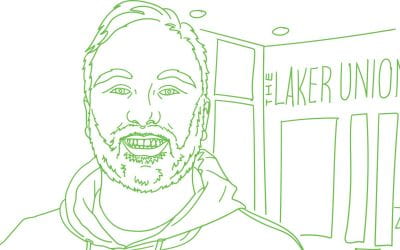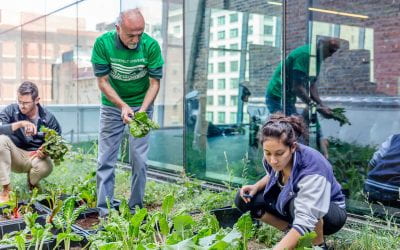Building community one glass floor at a time
By Carla Beecher

When Chicago architecture critic Blair Kamin reviewed the Wabash Building 10 years ago, he wondered whether the vertical campus would foster community. It does.
Bright, enthusiastic and helpful, senior Meli Frugoli is putting her hospitality and tourism major to work early as a student ambassador. As one of the first people visitors encounter, Frugoli meets, greets and gives tours to introduce prospective students and their families to the Roosevelt experience.
“I first came to Roosevelt eight years ago when I was 16,” … “I still vividly remember my tour of the Wabash Building, specifically the 31st-floor study room. When I saw it and the view, I said to myself, ‘Oh my gosh, I have to go here. It’s so beautiful.’ I feel like I’ve come full circle now that I am the one giving the tours!”
In many ways, both the Wabash and Auditorium buildings speak for themselves. The second-floor bridge connects the two architecturally significant buildings, each providing prime examples of both the old and the new.
Frugoli explained that in the Wabash Building, all the classrooms, office and public spaces such as the gym, the cafeteria and the Student Union Lounge, are on the bottom half the building (floors 1 to 13), and floors 14 to 31 are two- to four-bedroom dormitories suites with bathrooms totaling 633 beds (students use their student ID to get through the manned security gate on the 14th floor). The dormitory floors have access to study rooms, a kitchen and big lounge areas with TVs and game tables.
“It’s a great place to hang with other students,” … “And it’s especially nice for those coming from out of state or out of the country because with everything in one building it relieves a lot of the stress of being in a new environment. Students can acclimate to the city slowly.”
There’s also a lending closet on the third floor where students can sift through donated casual and business clothes to find outfits for interviews or networking opportunities. And the small in-house convenience store on the second floor is open 24/7 for students to grab-and-go personal items or a snack. “It’s not uncommon to see students in their pjs riding the elevator,” she said. “This is their home.”
Because everything students need is in either one building or the other, it’s easy to never venture outdoors. “It’s just so convenient,” she said. “So, one tip I always pass along to new students is to make sure they regularly go outside to experience the city.”
“The Wabash Building is a great community space for both residents and commuter students. It brings people together: You just know you’re going to run into someone from class or the gym or a campus club. It definitely helps to connect us all — students, teachers and staff.”
More in this section
Science labs foster collaboration and creativity
When plans were being drawn up for the new Wabash Building, they made sure to include state-of-the art laboratories to house the university’s chemistry, biology, biochemistry, health sciences and physics labs
Mixing it up with the city
Living, learning, working and volunteering in the Wabash building gives Sullivan a unique perspective on this glass and steel vertical campus.
Building as teacher
Professor Michael Bryson, PhD, has sweeping views about sustainability from his 27 years at Roosevelt.



